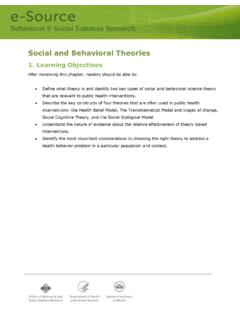Transcription of Evaluating the Quality of Health Care - esourceresearch.org
1 Evaluating the Quality of Health Care 1. Learning Objectives After reviewing this chapter readers should be able to: Define Quality of Health care;. Understand different approaches to assessing Quality of Health care;. Be aware of examples of structure, process, and outcome measures of care Quality ;. and Know approaches to developing or selecting measures of care Quality for a research project. 2. Introduction Almost everyone would say that they want high Quality Health care and most people have an intuitive sense of what that means.
2 When one wants to develop a research project related to Quality of care, however, one quickly finds what is true in many areas of research; that it is much easier to have a sense of what Quality is than it is to develop an operational definition and valid and reliable measures of Quality . Part of this complexity in defining Quality of care is that different groups can have very different reasons for measuring Quality and hence different measurement criteria and emphases. For example: Clinicians or those who manage and provide clinical care might be interested in Evaluating Quality so that they can monitor and improve the services they are providing to individual patients.
3 Regulators may be interested in ensuring that care provided by a Health care organization ( Health plan or hospital) meets a minimal standard and/or is making credible efforts to improve care Quality . Consumers and other purchasers may be most interested in information that they can use to select clinicians or Health care organizations. Although all of these parties might agree on a definition of high Quality care they might select different measures and researchers studying these different areas might have similar variations in emphases.
4 2. Introduction There is still a tremendous need for more work in measuring and improving the Quality of care in the United States. For example, Schuster et al., In spite of the (1998) reviewed a large number of studies and pronouncement of many found that only 50% of patients studied received that the United States recommended preventative care, only 70%. has the best Health care received recommended acute care, 30% received in the world studies contraindicated acute care, only 60% received consistently find that recommended acute care, and 20% received care is far from optimal.
5 Contraindicated chronic care. In a subsequent study, McGlynn et al., (2003) found that participants only received about 55 percent of recommended care. 3. Defining Quality of Care There are many definitions of Quality of care, but the Institute of Medicine (IOM) has proposed one that captures well the features of many other definitions and that has received wide acceptance (Institute of Medicine, 2001; Lohr & Committee to Design a Strategy for Quality Review and Assurance in Medicare, 1990): The degree to which Health services for individuals and populations increase the likelihood of desired Health outcomes and are consistent with current professional knowledge.
6 As compelling as that definition is, it does not provide much guidance to a researcher interested in developing a measure or set of measures. A subsequent IOM report specified seven aims of a high Quality medical care system that are more specific (Institute of Medicine, 2001): Safe avoiding injuries to patients from the care that is supposed to help them. Effective providing services based on scientific knowledge to all who could benefit and refraining from providing services to those not likely to benefit (avoiding underuse and overuse).
7 Patient-centered providing care that is respectful of and responsive to individual patient preferences, needs, and values and ensuring that patient values guide all clinical decisions. Timely reducing waits and sometimes harmful delays for both those who receive and those who give care. Efficient avoiding waste, in particular waste of equipment, supplies, ideas, and energy. Equitable providing care that does not vary in Quality because of personal characteristics, such as gender, ethnicity, geographic location, and socioeconomic status.
8 3. Defining Quality of Care These aims describe two related, but distinct types of excellence; technical and interpersonal (Donabedian, 1965, 1988). Interpersonal excellence refers to care that meets the information, emotional, and physical needs of patients in a way that is consistent with their preferences and expectations. Another term for this type of care is "patient-centered care" (Cleary, P. D., Edgman-Levitan, et al., 1991). One important aspect of interpersonal care is patient involvement in decision making (Barry, Fowler, Mulley, Henderson, & Wennberg, 1995.)
9 Braddock, Edwards, Hasenberg, & et, 1999; President's Commission for the Study of Ethical Problems in Medicine and Biomedical and Behavioral Research, 1982; Sepucha & Mulley Jr, 2009) . It is important to distinguish between excellence of interpersonal care and patient satisfaction. Patient satisfaction is commonly measured and many consider it an indicator of medical care Quality . However, patients may be satisfied with poor Quality care (Cleary, P. D. & McNeil, 1988). Thus, it is important to specify interpersonal aspects of high Quality care and ask patients to report about those experiences.
10 It may also be useful to rate the extent to which care met patient expectations, but it . is important to recognize that high satisfaction does not necessarily imply high Quality . Exercise 1: For each of the following, decide which question is mainly a rating and which is mainly a report about care Quality . 4. Types of Quality of Care Measures Although the aims above suggest how one might measure Quality , there are multiple approaches to measuring different aspects of Quality . One of the first comprehensive works that focused on Quality of care was published in a series of three books by Avedis Donabedian (Donabedian, 1980, 1982, 1985).










